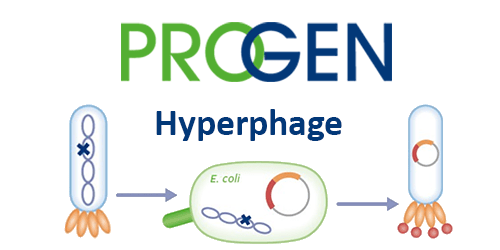PROGEN - Hyperphages for Antibody Production
The Hyperphage System - Animal-free Recombinant Antibody development
The hyperphage system, which is also known as helper phage technology, was developed by Rondont et al., 2001 and is an animal-free way to produce recombinant antibodies. It has revolutionized the field of antibody engineering and drug discovery because it improves antibody presentation in phage display by increasing the number of antibodies displayed per phage particle (up to 5 vs. 0.01), compared to normal helper phages.
Bacteriophages are viruses that infect bacteria and these are needed for the hyperphage system. The most commonly known bacteriophage for phage display is the M13 phage. The bacteriophage M13 only infects E. coli strains.
The displayed antibodies on the phages can be used for various applications, such as identifying specific targets or in immune response or disease treatment related research. Read more
The Hyperphage System
Hyperphages enable complete and multivalent antibody presentation. As they are of wildtype pIII phenotype they are able to infect E. coli cells with high efficiency, but they do not carry a functional pIII gene. Therefore, the phagemid encoded scFv-pIII fusion protein is rendered as the sole source of pIII in phage assembly. This results in an increase of the fraction of phage particles carrying an antibody fragment on their surface.
Antigen binding activity is increased about 400 fold by enforced oligovalent antibody display on every phage particle. After two panning rounds, more than 50% of the phage were found to bind to the antigen, compared to 3% when conventional helper phages are used.
- Exceptional reproducibility: production in cell cultures or microorganisms ensures high reproducibility and consistent quality
- Future-proof supply: an animal free platform ensures your recombinant antibodies can be produced again and again
- Fast production: quicker production in comparison to monoclonal or polyclonal antibody production
- Controlled conditions: ensures precise manipulation, prevents contamination, provides optimal growth, quality control and scalability
- Animal free: animal-free production in bacterial cultures!

Antibody Library Preparation
The first step is to create antibody variable heavy (VH) and light chain (VL) PCR products. Antibody PCR products are ligated into the pSEX81 surface expression vector (phagemid). This creates a fusion protein containing VH and VL combined with the pIII minor capsid protein derived from the M13 bacteriophage.
Hyperphage Display
Hyperphages carry a deletion in the pIII gene. They are generated by an E. coli packaging cell line producing functional pIII. The resulting hyperphages carry functional pIII on their surface but lack the pIII gene in their genome. These hyperphages can be used to infect bacteria with a phagemid library. Due to the resulting display phages carrying several copies of the antibody or peptide on its surface, panning efficiency is increased dramatically.
Quantification
The anti-M13/fd/F1 specifically detects the phage outer surface protein pVIII. Using the Phage Titration ELISA, a standard curve is prepared using a dilution series of phage suspension of known titer. The particle number is estimated in comparision to the standard curve.
Expression of functional recombinant single-chain Fv antibody fragments in E. coli
The identified clones of interest can easily be produced by E. Coli. This is done by transforming the bacteria with the pOPE101 Expression Vector, which includes the desired antibody fragment. As the expression vector contains a c-Myc and His-tag, the expressed antibody fragment can be purified by metal chelation or affinity purification.

